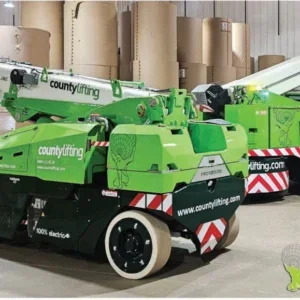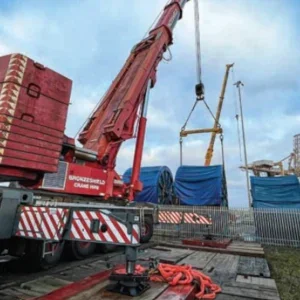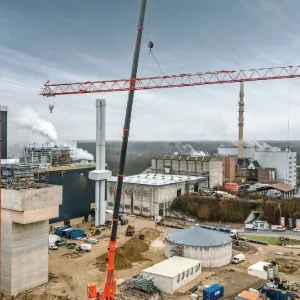Unlike many crane safety devices, which restrict operators in their work, the use of a camera can make the operator’s job easier and less stressful. As Joost Fons, of Holland-based camera supplier Orlaco, points out: “The benefits achieved from the camera, such as speed and safety, give a direct return on investment. In most cases the cost of the camera system is earned back through job efficiency within one year.”
Nonetheless, he says, some are reluctant to fit cameras because they do not want to be early adopters of what they see as an, as yet, unproven technology. “Companies that adopt the system first in the market are those who care for their employees, and who also have a long-term vision that providing a top class service is the best guarantee to survive,” says Fons.
Although many contractors have yet to be convinced of the business benefits of using cameras, it is a different story in the rental market, Fons says: “Most people with any knowledge of cranes clearly understand the advantages of load view cameras.”
Essentially, cameras have three common applications on cranes, offering the operator a view of the load, the winch, or the rear of the crane.
Load-view cameras are usually mounted on the boom tip of a lattice or telescopic boom crane or to the trolley of a tower crane, and point downwards toward the hook. In the case of a lattice or telescopic boom, the angle of the boom changes constantly. To correct the position of the camera automatically, load-view cameras are often mounted on an oil-damped swing bracket, and a monitor is installed inside the cabin for viewing the camera image.
Most load-view cameras have a zoom facility. With a remote control in the cabin or with buttons on the monitor, the crane operator can zoom in to objects on the work floor. Orlaco also offers night vision as an option. “These features,” says Fons, “give the operator a much more detailed and clearer view of the crane load than he can get purely through his own eyes.”
Orlaco believes this is a significant safety feature for three reasons.
First, the system gives the operator the opportunity to communicate better with the banksman on the ground since, with the help of the camera, the driver can observe the banksman’s hand and arm gestures himself.
Secondly, in case of unstable loads or other dangerous lift situations – for example, the hook getting stuck – the driver can react immediately. Thirdly, the load-view camera system gives the operator a clear indication of the final position of a swinging crane hook. He can rely on the fact that the crane hook will always end up right in the centre of the monitor.
A load view camera can be installed on mobile cranes from 40t capacity and bigger. In the tower crane market, the top slewing cranes are of interest to camera manufacturers. Almost all mobile harbour cranes – constantly confronted with blind lifts – are now equipped with a load-view camera.
Nevertheless, Fons says the introduction of load view cameras to the crane market has only just begun. “The only market where the product has been launched on full scale is the Dutch market, resulting in 25 to 30% of all mobile cranes in Holland having a load view camera,” he says. “In the remainder of Europe, their introduction is still ongoing.”
Fons notes that in Sweden, Norway, Denmark, Germany, Switzerland, Belgium, France and Finland, systems are now being installed. He expects that Spain, Portugal and Italy will follow.
In the mobile market, the big four – Liebherr, Terex-Demag, Grove, and Tadano-Faun – have started offering load-view cameras as an option.
In other markets – for example, mobile tower crane supplier Spierings, and harbour crane supplier Gottwald – put cameras on as standard.
A second type of camera used in cranes is the rear view camera. It is sometimes combined with navigation systems, and is typically installed on larger mobile cranes. Again, it is a useful tool for the crane operator because it enables him to operate a crane on a narrow jobsite.
Finally, winch view cameras are now being installed on large telescopic and crawler cranes where the driver has no direct view of the winch from the cabin. “All crane drivers know that a good look at a winch is critical to know when and with what speed lifting is taking place,” says Fons. “Besides, over viewing rolling of the lifting cable on the winch is necessary to prevent twisting of the cable.”
Fons points out that the cost of replacing one lift cable exceeds the costs of a winch view camera by many times. On some occasions the monitor used for the load view camera can also be used for displaying the winch view camera.
Terex Demag provides camera systems on around 10% of its crawler cranes, significantly more than on its all-terrains. Marketing director Christian Schorr-Golsong says the cost of camera viewing systems is a contributory factor in the industry’s reluctance to embrace viewing systems in a broader sense, but he reckons it is hard to make reductions. He says the cost of the units is fixed, adding: “We use standard components, and there is a limited possibility to reduce the cost of the installation.”
He therefore reckons that the attraction of extra health and safety assurances will be a bigger pull.
Where they are fitted on the superstructure of Terex-Demag crawler cranes, cameras are used to monitor the winches. “The operator can check whether the ropes are wound properly, and that there is no rope hanging down,” Schorr-Golsong says. “In general,” he continues, “the cameras make life easier for the operators. They just have to watch the screen, and have full control of things going on around the crane.”
However, Schorr-Golsong does point to one disadvantage: “There are additional electronics which need to be installed and this increases the complexity of the crane,” he says.
Scotland-based crane parts and services supplier Samuel Walker & Sons has been selling cameras, both black and white and colour, for some time. Sales manager Mike Moore says that the market has been slow to take off, but it shows signs of promise: “Once a customer has a camera fitted on their crane they are hooked. We have been asked to fit cameras into the engine room of reeling drums to monitor the cable, and this has been very effective. Cameras are the way to go in the future and as more and more OEMs fit them as standard the better for the market and for safety.”
Moore believes that health and safety issues will be a massive driver in future camera sales. He points out that 25% of all fatalities involving vehicles at work occur while the vehicle is reversing.
“Many more accidents,” he continues “do not result in injury, but cause costly damage to vehicles and equipment.”
Crane manufacturing giant Liebherr says that around 75% of its offshore customers use camera systems, while harbour mobile crane customers (30%) and crawler crane customers (5%) have much less demand for them.
Boom tip cameras are recommended and always included as an option on Liebherr’s offshore cranes. On the bigger harbour mobile cranes, Liebherr says it is also standard practice to use a camera.
Deck cranes, Liebherr continues, do not usually need cameras, and they are only offered as an option. Liebherr notices that in offshore applications customers respond “very positively” to cameras. But in other areas of lifting and cargo handling the customers have to be convinced of the positive reasons for using a camera.
It is interesting that, if anything, the external pressures on improving levels of health and safety will drive the industry closer to the apparent luxury of camera systems than it might ever have achieved on its own two feet or as the fruit of its own initiative.






